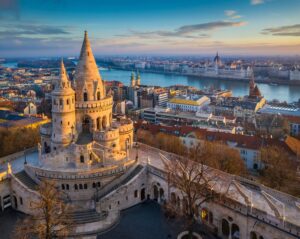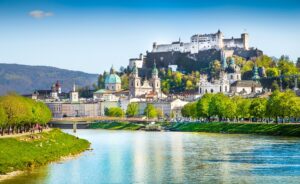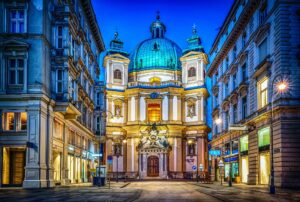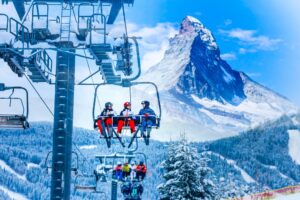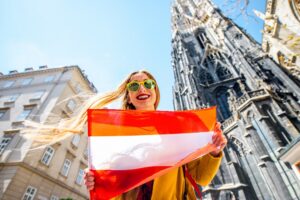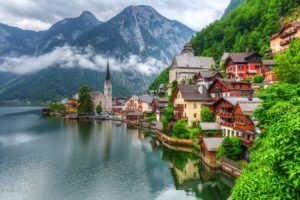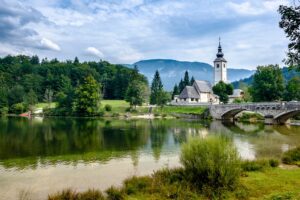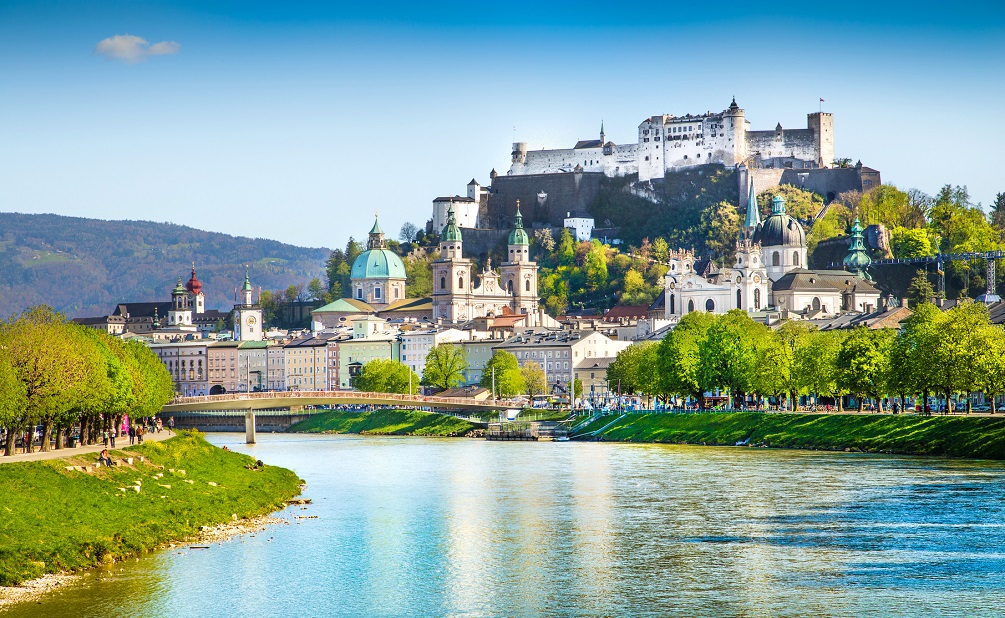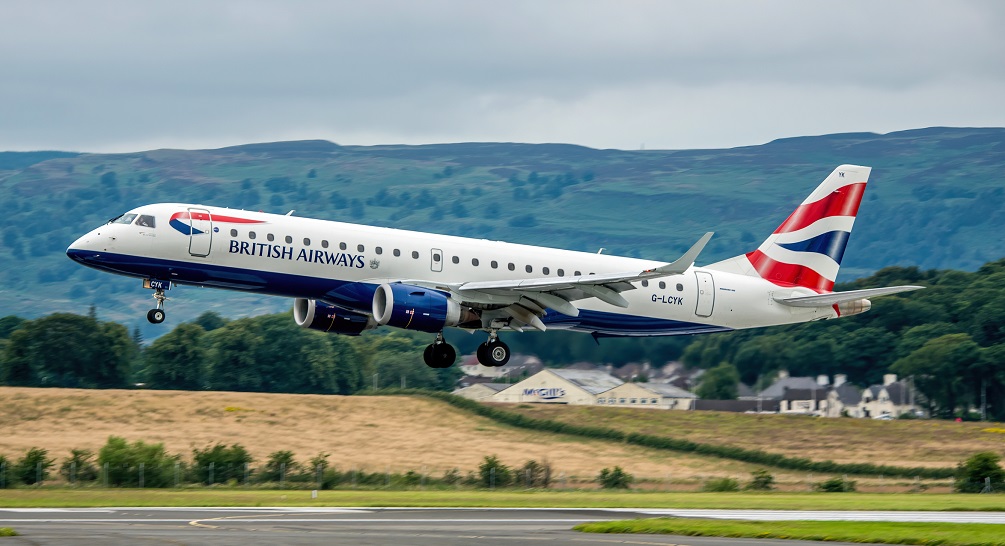Austria
Austria's picturesque towns, set against a backdrop of the snow-capped mountains and undulating hills of the Alps, offer a taste of Europe at its finest.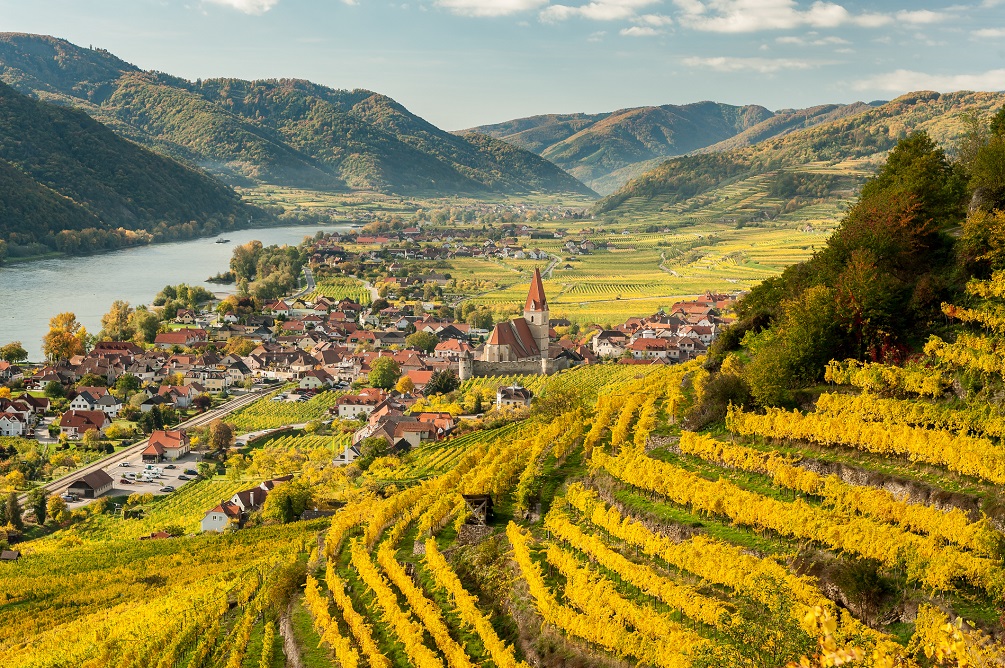
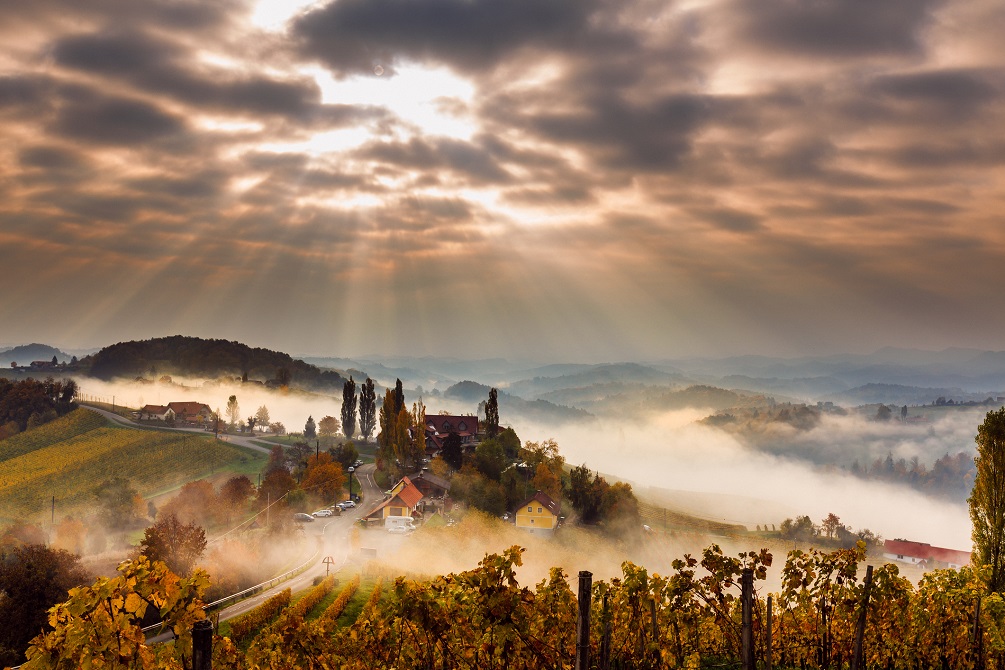


Landlocked in the heart of Europe, Austria shares a border with the Czech Republic and Germany in the north. To the south lies Slovenia and Italy and to the east are Slovakia and Hungary. Switzerland and Liechtenstein lie in the west.
Austria is home to nearly three-quarters of the Alps: the Central Eastern Alps, Northern Limestone Alps, and the Southern Limestone Alps. Therefore, mountains and forests are the centerpieces of the country’s topography.
The Alps in the west give way to lowlands and plains on the eastern side of the country. Vienna, the capital, is on the drier plains directly south of the Danube River, which is the greatest river that traverses through 10 European countries and flows through the northern areas of Austria.
Aside from the Danube River, there are several lakes in Austria.
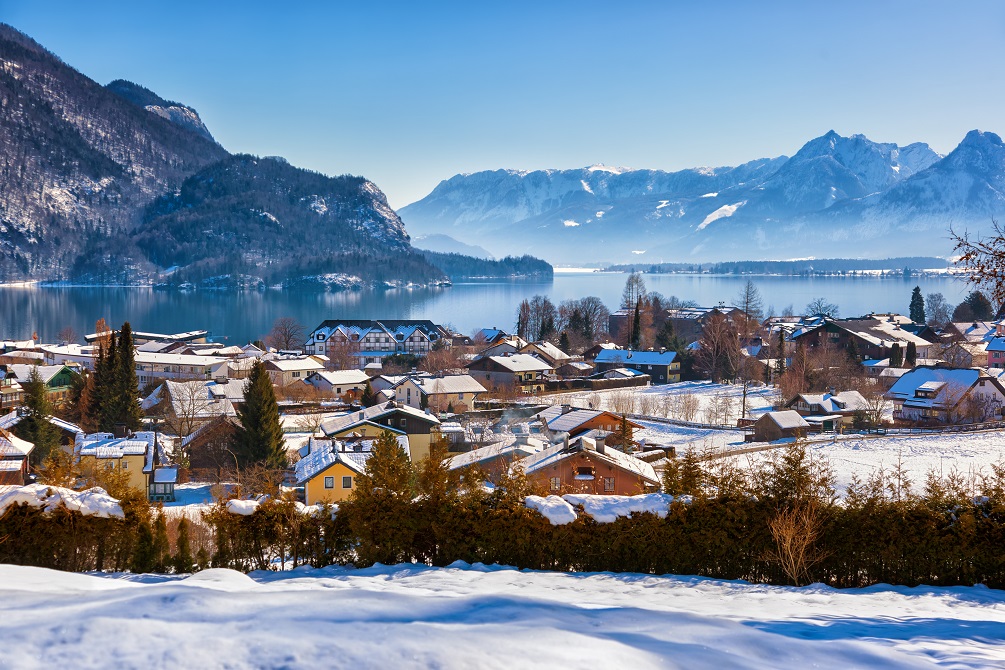


There are mild variations in the climate across Austria, ranging from temperate to alpine.
In the north and eastern lowlands where the capital, Vienna, resides, winters are colder and summers hotter than the rest of the country. Also, rainfall is moderate during the year.
Summers in the south-eastern regions of Styria and Burgenland are lengthy and hot, with Mediterranean-like weather.
Austria’s temperate Atlantic climate is more prevalent in the country’s western regions of Vorarlberg and Tyrol. The weather is often much more controlled, with winters mild and summers warm. Precipitation is much higher in this region compared to the rest of the country.
An alpine climate prevails in the mountainous areas where the altitude is much higher, resulting in colder winters. At high altitudes, the weather can change drastically and quickly.
January is the coldest month in Austria before temperatures rise in February. Summers (June to August) can get hot, with temperatures rising to 30 °C (86 °F). July is the hottest month of the season, with a maximum temperature as high as 35 °C (95 °F). Evenings are much cooler than in the daytime.
The driest months are May, September, and the first half of October. The most precipitation occurs in April and November.
The best time to visit Austria is between April and September. You can enjoy a dip in the lakes or attend the Salzburg Festival, the Vienna Festival, or the Rainbow Parade.
Visiting between September and October is prime as well. While winter can be chilly, it’s the perfect time to go skiing in the Austrian Alps. If you’re not a skier, you can visit the charming Vienna Christmas market.
Hikes are great during spring, as you can delight in the magnificent scarlet and golden hues of the surrounding foliage.
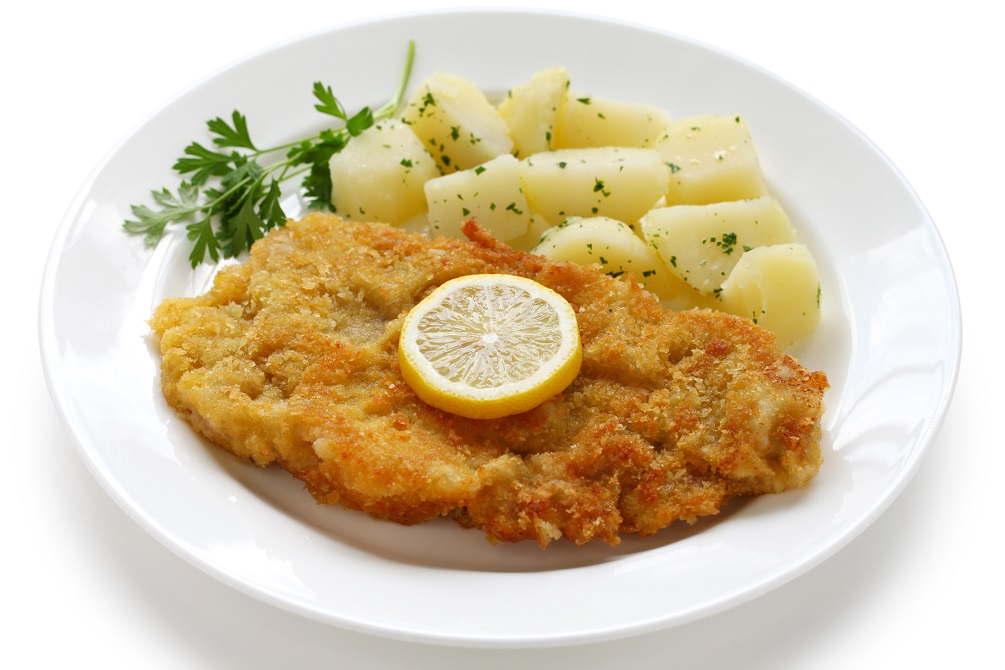


Seasonal, elegant, and full of delectable culinary innovations, Austrian food is a treat.
Austrian cuisine is the most multi-ethnic and transnational compared to other European cuisines. Regional traditions have shaped the dishes and preparation styles, which have also been influenced by Hungarian, French, Jewish, Czech, Italian, Polish, and Balkan cuisines.
Because seasonality affects popular foods, there is always something to look forward to throughout the year: asparagus in the spring, apricots in the summer, hare, game, and new wine in the autumn.
Wiener schnitzel is a traditional Austrian dish made of breaded veal.
Other popular dishes include Kärntner Kasnudeln (dough stuffed with Topfen, potatoes, herbs, and peppermint), Kaiserschmarren (Shredded pancakes), and Tafelspitz (beef or veal boiled in broth and served with horseradish and minced apples).
Austria is famous for its coffee and Mozartkugeln (candies made of pistachio, marzipan, nougat, and covered with dark chocolate). The country also has a long-standing tradition of winemaking dating back to the Celts and Romans.
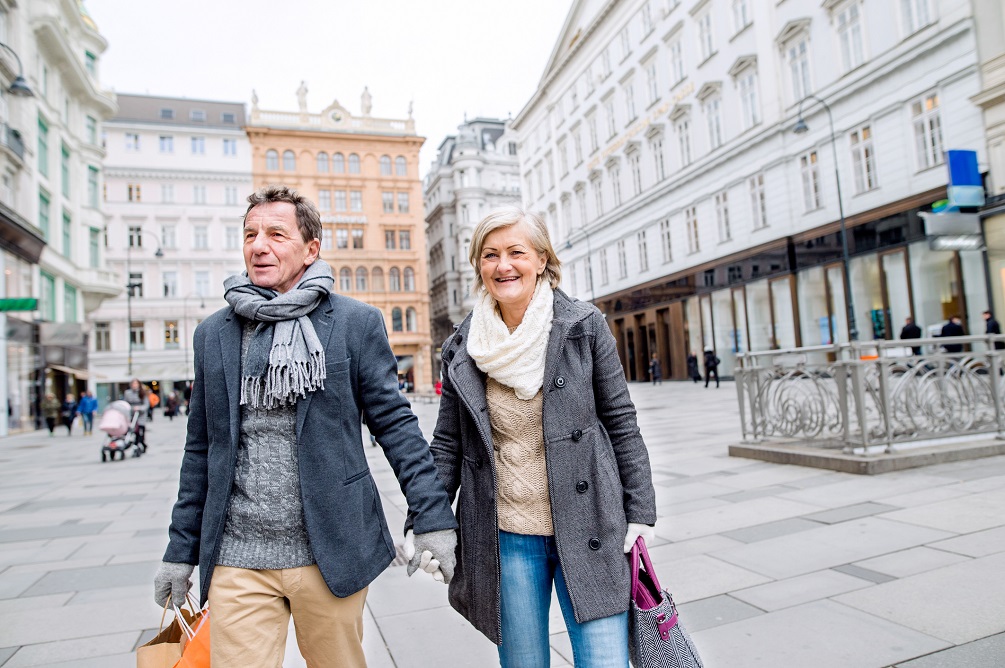


Austrian residents dress casually, with a touch of elegance and sophistication.
T-shirts and baseball hats are among the items you should avoid bringing with you.
For a summer trip, it’s best to pack light and breathable clothing and a sweater or jacket for cool evenings. A chic pashmina or shawl is essential for women. Also, bring along a raincoat or waterproof jacket if you’re traveling during the rainy season.
Winters are cold, so bring a thick waterproof coat, a toasty beanie, mittens or gloves, and a warm scarf. To keep your feet especially warm, bring a good pair of boots with thick rubber soles.
Dressing in layers is best regardless of the time of year you’re visiting.
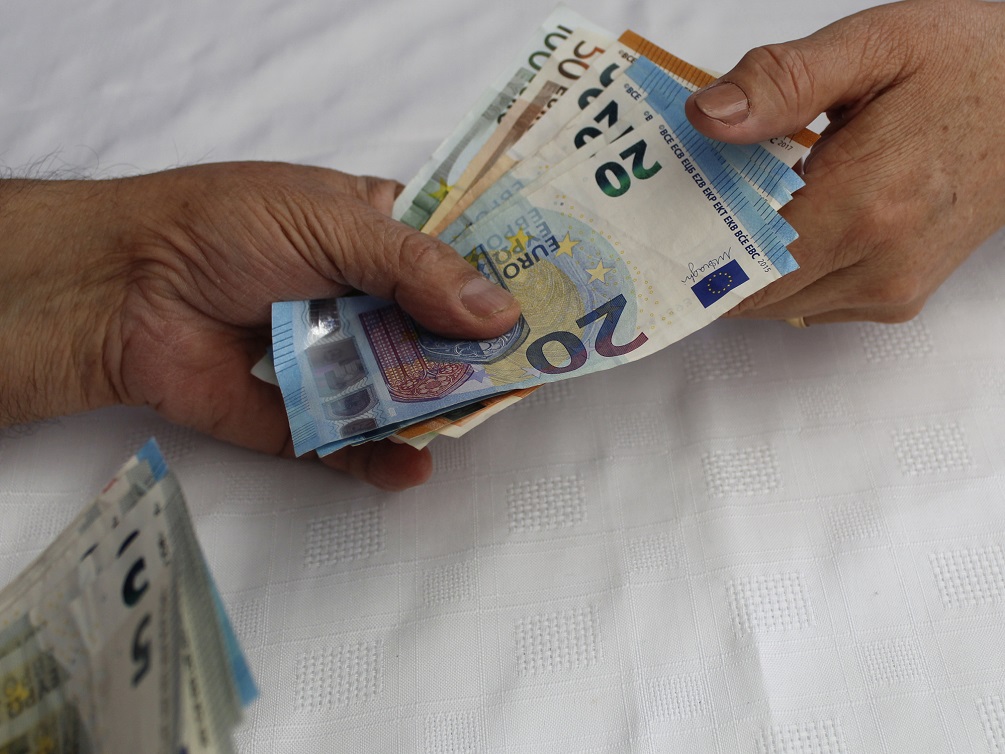


The official currency of Austria is the euro (EUR). One euro is subdivided into 100 cents.
Banknotes come in denominations of 5, 10, 20, 50, 100, 200, and 500. However, the 200 and 500 EUR notes are rarely used or accepted. You’ll also find 1 and 2 euro coins. Cents come in denominations of 1, 2, 5, 10, 20, and 50 coins.
You can use your debit or credit card to pay for goods and services in larger shops, hotels, malls, and upmarket restaurants.
Despite accepting cards, Austria is not an entirely cashless society. It’s possible that you’ll have to pay with cash in smaller stores and simple cafés. Use as many small bills and coins as possible, since they may not always have changed.
Cash is especially important if you’re going to the Christmas, Easter, or New Year markets.
ATMs (locally Bankomaten) are common in Austria, even in smaller towns. Some are open 24/7, while others close after midnight. The withdrawal limit is typically EUR400.
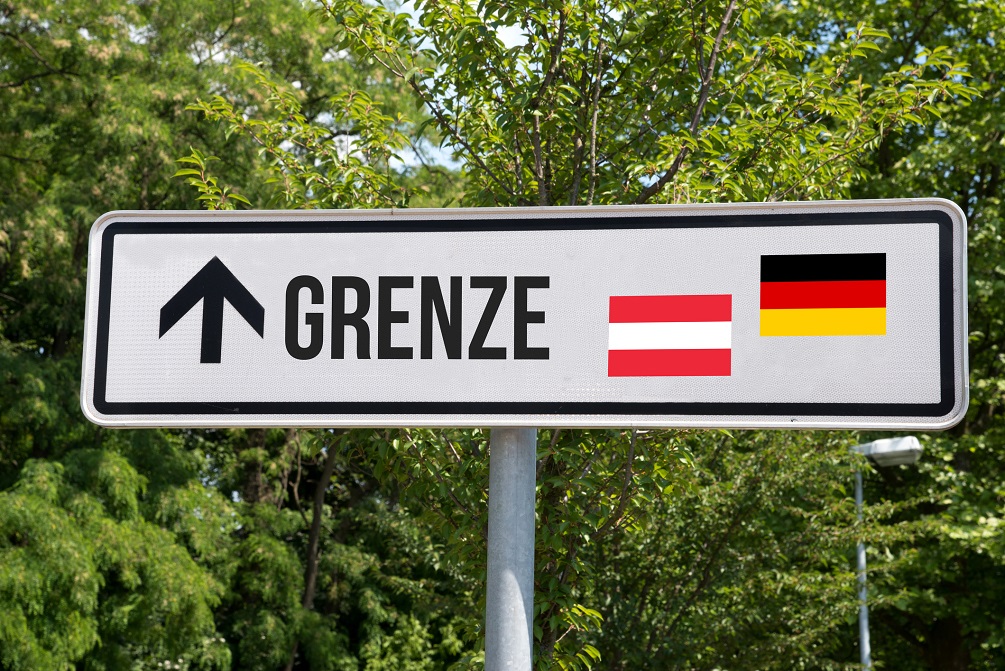


Austrian German is the official language and lingua franca of Austria.
Except in the west, the dialect of German spoken by 98% of Austrians is Austro-Bavarian. It bears some similarities to standard German but has vocabulary differences.
In Austria’s various regions, there are minor nuances in Austrian German. You might find that people from the country’s westernmost regions don’t grasp what those from Vienna are saying. That’s because residents of Vorarlberg and the Reutte District of Tyrol speak an Alemannic (Swiss) dialect.
Other languages spoken by the minority groups include Croatian, Slovene, Hungarian, and Turkish. The official language in the southern province of Carinthia is Slovene.
Although over 70% of the Austrian population speaks English, understanding the local language can help you immerse yourself in the culture and make the most of your trip. To get you started, here are some frequently used Austrian German words and phrases:
- Good Morning – Guten Morgen (Can be shortened to Morgen; pronounced Moagn)
- Good afternoon/evening – Grüss Gott (translates to ‘greet God’)
- Hello (informal) – Servus/Hallo
- Goodbye – Auf Wiedersehen/Auf Wiederschauen
- Bye (informal) – Tschüss/Priat di
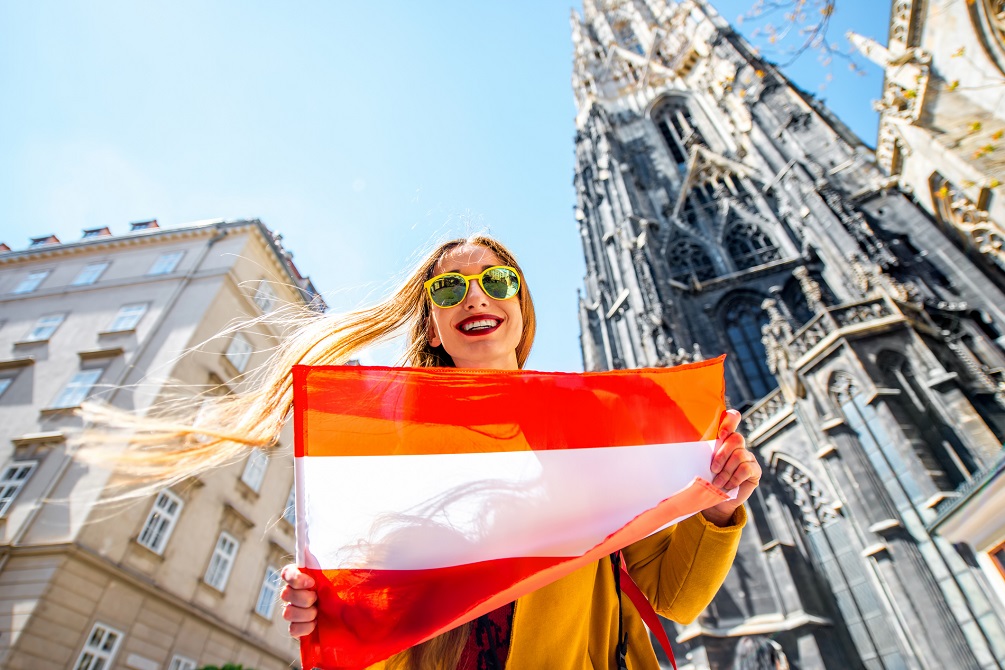


Despite parallels to Germany and Switzerland’s cultures, Austrians have established their own distinct identity and traditions.
Austrian culture is what it is today because of the Habsburg Empire and the Christian church. Residents of Vorarlberg and western Tirol have cultural ties to the German-Swiss to the west and the Swabians in Germany to the north.
The largest ethnic minority group is the Turks, followed by the Serbs.
Christianity is the most widely practiced religion in the country, and it plays a big role in many people’s lives. Over 70% of Austrian Christians belong to the Roman Catholic Church and a small percentage is Protestant. Some residents profess Islam as well.
Austria is known around the world for paving the way for music, medicine, theatre, literature, and architecture.
Famous composers like Wolfgang Amadeus Mozart were natives of Austria and Beethoven, Brahms, and Strauss are linked with the country, despite being outsiders.
The two major genres linked with Vienna were the waltz and opera.
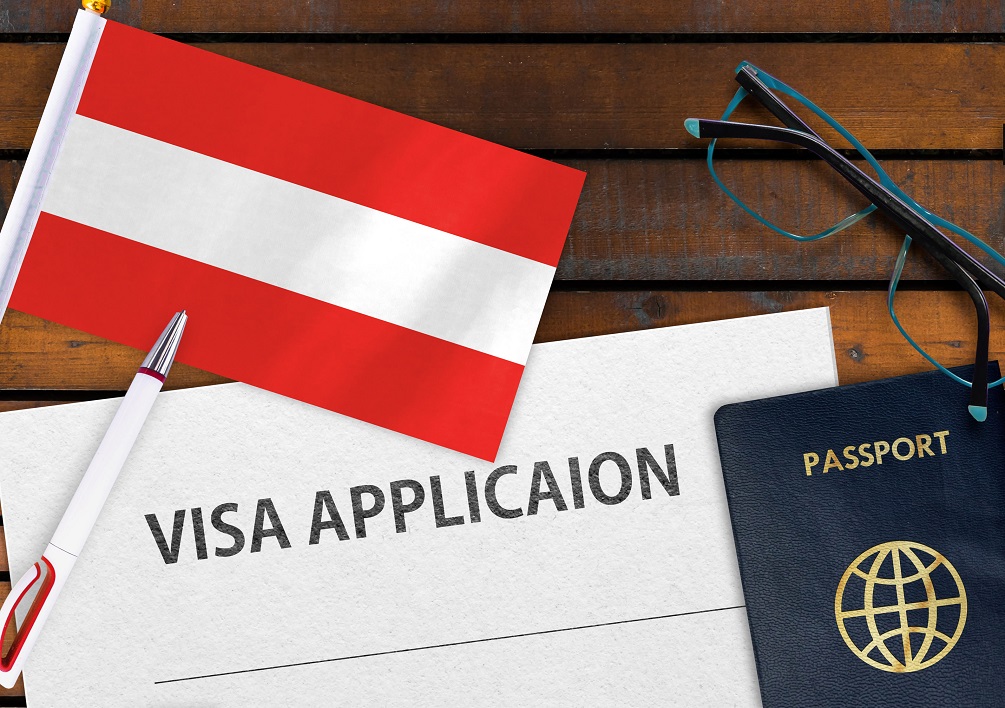


British Nationals don’t need a visa to travel to Austria and other countries in the Schengen area. You can stay for up to 90 days in any 180-day period. Ensure your stay is within the 90-day limit, especially if you plan on visiting other Schengen countries.
For stays longer than 90 days, you must meet the Austrian government’s entry requirements. You should enquire with the Austrian embassy to find out what type of visa you may need.
You may need to show that you have onward travel or return ticket and sufficient money for your stay.
Your passport should be valid for at least 3 months after the date you depart from Austria. It should not be older than ten years as well.
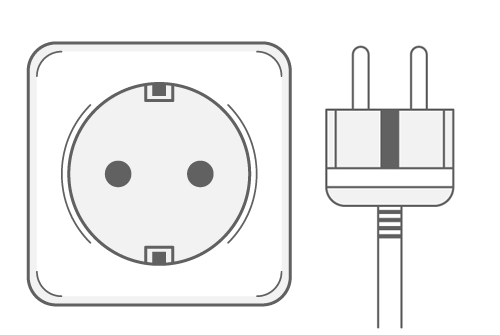


The plug and sockets used in Austria are Type F (round with two prongs).
The power sockets supply a standard voltage of 230 V and a standard frequency of 50 Hz.
You should bring along a universal adapter with surge protection and a convertor for hairdryers and hot tools.






Landlocked in the heart of Europe, Austria shares a border with the Czech Republic and Germany in the north. To the south lies Slovenia and Italy and to the east are Slovakia and Hungary. Switzerland and Liechtenstein lie in the west.
Austria is home to nearly three-quarters of the Alps: the Central Eastern Alps, Northern Limestone Alps, and the Southern Limestone Alps. Therefore, mountains and forests are the centerpieces of the country’s topography.
The Alps in the west give way to lowlands and plains on the eastern side of the country. Vienna, the capital, is on the drier plains directly south of the Danube River, which is the greatest river that traverses through 10 European countries and flows through the northern areas of Austria.
Aside from the Danube River, there are several lakes in Austria.



There are mild variations in the climate across Austria, ranging from temperate to alpine.
In the north and eastern lowlands where the capital, Vienna, resides, winters are colder and summers hotter than the rest of the country. Also, rainfall is moderate during the year.
Summers in the south-eastern regions of Styria and Burgenland are lengthy and hot, with Mediterranean-like weather.
Austria’s temperate Atlantic climate is more prevalent in the country’s western regions of Vorarlberg and Tyrol. The weather is often much more controlled, with winters mild and summers warm. Precipitation is much higher in this region compared to the rest of the country.
An alpine climate prevails in the mountainous areas where the altitude is much higher, resulting in colder winters. At high altitudes, the weather can change drastically and quickly.
January is the coldest month in Austria before temperatures rise in February. Summers (June to August) can get hot, with temperatures rising to 30 °C (86 °F). July is the hottest month of the season, with a maximum temperature as high as 35 °C (95 °F). Evenings are much cooler than in the daytime.
The driest months are May, September, and the first half of October. The most precipitation occurs in April and November.
The best time to visit Austria is between April and September. You can enjoy a dip in the lakes or attend the Salzburg Festival, the Vienna Festival, or the Rainbow Parade.
Visiting between September and October is prime as well. While winter can be chilly, it’s the perfect time to go skiing in the Austrian Alps. If you’re not a skier, you can visit the charming Vienna Christmas market.
Hikes are great during spring, as you can delight in the magnificent scarlet and golden hues of the surrounding foliage.



Seasonal, elegant, and full of delectable culinary innovations, Austrian food is a treat.
Austrian cuisine is the most multi-ethnic and transnational compared to other European cuisines. Regional traditions have shaped the dishes and preparation styles, which have also been influenced by Hungarian, French, Jewish, Czech, Italian, Polish, and Balkan cuisines.
Because seasonality affects popular foods, there is always something to look forward to throughout the year: asparagus in the spring, apricots in the summer, hare, game, and new wine in the autumn.
Wiener schnitzel is a traditional Austrian dish made of breaded veal.
Other popular dishes include Kärntner Kasnudeln (dough stuffed with Topfen, potatoes, herbs, and peppermint), Kaiserschmarren (Shredded pancakes), and Tafelspitz (beef or veal boiled in broth and served with horseradish and minced apples).
Austria is famous for its coffee and Mozartkugeln (candies made of pistachio, marzipan, nougat, and covered with dark chocolate). The country also has a long-standing tradition of winemaking dating back to the Celts and Romans.



Austrian residents dress casually, with a touch of elegance and sophistication.
T-shirts and baseball hats are among the items you should avoid bringing with you.
For a summer trip, it’s best to pack light and breathable clothing and a sweater or jacket for cool evenings. A chic pashmina or shawl is essential for women. Also, bring along a raincoat or waterproof jacket if you’re traveling during the rainy season.
Winters are cold, so bring a thick waterproof coat, a toasty beanie, mittens or gloves, and a warm scarf. To keep your feet especially warm, bring a good pair of boots with thick rubber soles.
Dressing in layers is best regardless of the time of year you’re visiting.



The official currency of Austria is the euro (EUR). One euro is subdivided into 100 cents.
Banknotes come in denominations of 5, 10, 20, 50, 100, 200, and 500. However, the 200 and 500 EUR notes are rarely used or accepted. You’ll also find 1 and 2 euro coins. Cents come in denominations of 1, 2, 5, 10, 20, and 50 coins.
You can use your debit or credit card to pay for goods and services in larger shops, hotels, malls, and upmarket restaurants.
Despite accepting cards, Austria is not an entirely cashless society. It’s possible that you’ll have to pay with cash in smaller stores and simple cafés. Use as many small bills and coins as possible, since they may not always have changed.
Cash is especially important if you’re going to the Christmas, Easter, or New Year markets.
ATMs (locally Bankomaten) are common in Austria, even in smaller towns. Some are open 24/7, while others close after midnight. The withdrawal limit is typically EUR400.



Austrian German is the official language and lingua franca of Austria.
Except in the west, the dialect of German spoken by 98% of Austrians is Austro-Bavarian. It bears some similarities to standard German but has vocabulary differences.
In Austria’s various regions, there are minor nuances in Austrian German. You might find that people from the country’s westernmost regions don’t grasp what those from Vienna are saying. That’s because residents of Vorarlberg and the Reutte District of Tyrol speak an Alemannic (Swiss) dialect.
Other languages spoken by the minority groups include Croatian, Slovene, Hungarian, and Turkish. The official language in the southern province of Carinthia is Slovene.
Although over 70% of the Austrian population speaks English, understanding the local language can help you immerse yourself in the culture and make the most of your trip. To get you started, here are some frequently used Austrian German words and phrases:
- Good Morning – Guten Morgen (Can be shortened to Morgen; pronounced Moagn)
- Good afternoon/evening – Grüss Gott (translates to ‘greet God’)
- Hello (informal) – Servus/Hallo
- Goodbye – Auf Wiedersehen/Auf Wiederschauen
- Bye (informal) – Tschüss/Priat di



Despite parallels to Germany and Switzerland’s cultures, Austrians have established their own distinct identity and traditions.
Austrian culture is what it is today because of the Habsburg Empire and the Christian church. Residents of Vorarlberg and western Tirol have cultural ties to the German-Swiss to the west and the Swabians in Germany to the north.
The largest ethnic minority group is the Turks, followed by the Serbs.
Christianity is the most widely practiced religion in the country, and it plays a big role in many people’s lives. Over 70% of Austrian Christians belong to the Roman Catholic Church and a small percentage is Protestant. Some residents profess Islam as well.
Austria is known around the world for paving the way for music, medicine, theatre, literature, and architecture.
Famous composers like Wolfgang Amadeus Mozart were natives of Austria and Beethoven, Brahms, and Strauss are linked with the country, despite being outsiders.
The two major genres linked with Vienna were the waltz and opera.



British Nationals don’t need a visa to travel to Austria and other countries in the Schengen area. You can stay for up to 90 days in any 180-day period. Ensure your stay is within the 90-day limit, especially if you plan on visiting other Schengen countries.
For stays longer than 90 days, you must meet the Austrian government’s entry requirements. You should enquire with the Austrian embassy to find out what type of visa you may need.
You may need to show that you have onward travel or return ticket and sufficient money for your stay.
Your passport should be valid for at least 3 months after the date you depart from Austria. It should not be older than ten years as well.



The plug and sockets used in Austria are Type F (round with two prongs).
The power sockets supply a standard voltage of 230 V and a standard frequency of 50 Hz.
You should bring along a universal adapter with surge protection and a convertor for hairdryers and hot tools.
Travel related news, information and inspirational articles and videos for travellers booking flights or holidays to Austria. Ask questions about travel in Austria and get answers from Austria experts
NEWS
Inspiration, Information and Travel Guides
MEET THE Austria EXPERTS
If you are looking to book a holiday to Austria or needs some help and advice planning travel to Austria then contact one of the UK based independent travel agents that specialise in Austria itineraries.
FEATURED VIDEOS
Your Travel Questions Answered
Ask any travel related question and get an answer from one of our experts that will provide you with an answer from their personal experience
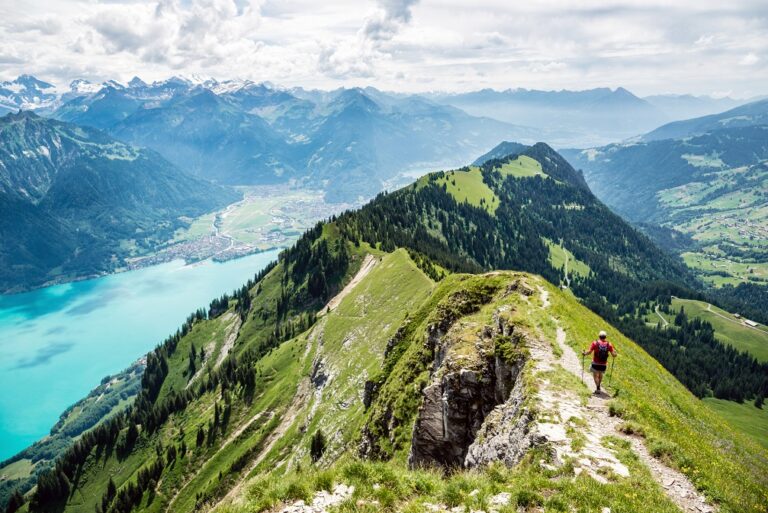

Me and my wife have been saving for years just so we could travel and explore different continents as we had always been travel enthusiasts. Recently, we realized that hiking and trekking mountainous terrain is our thing after we had a tour to the Andes. For our next destination, we have decided to explore the Alps, specifically Switzerland and Austria. Although on our Andes's journey, we hired a tour guide that helped us explore the hidden, attractive sites, we have decided to make our next journey without a tour guide, as tour guides usually oversee a group of people and we would like to travel alone. However, we are still uncertain whether it is a good idea to go on an unknown journey without a tour guide?


